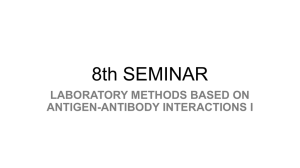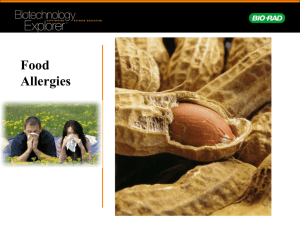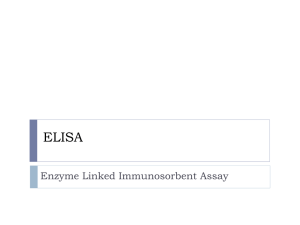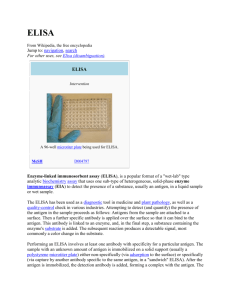ViewTTI screening
advertisement
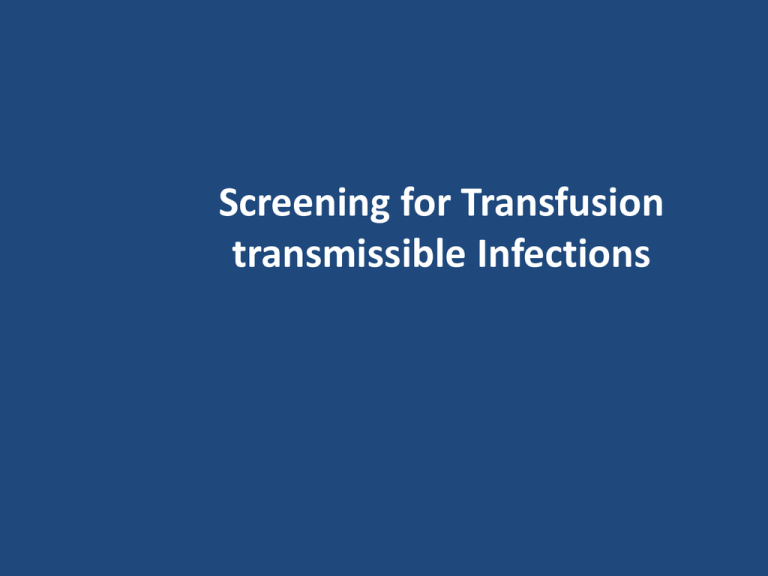
Screening for Transfusion transmissible Infections Teaching Aims • To understand the principle and performance of ELISA and Rapid tests • To learn about the interpretation and documentation of the tests • To identify troubleshooting and its resolution Transfusion transmitted infections Viral Hepatitis B HIV 1 & 2 Bacterial Syphilis Donor bacteremia Hepatitis C HTLV 1 & 2 Parasitic Hepatitis A Malaria HPV B19 Chagas’ disease CMV Prion disease Mandatory screening of Blood units Infectious agent Tests available HBV Rapid tests, ELISA and NAT HCV Rapid tests, ELISA and NAT HIV Rapid tests, ELISA and NAT Malaria PBF, Rapid tests, ELISA Syphilis VDRL, RPR, TPHA, ELISA Mandatory Test Under Drugs and Cosmetic Act 1940 Rules 1945, (SCH. F, Part XII B) ELISA for HIV I /II since 1989 ELISA for Hepatitis B surface antigen since 1985 ELISA for Antibody to Hepatitis C since 2001 VDRL/RPR for Syphilis Screening for Malarial Parasite “Rapid testing” APPLICATIONS: • Low Annual collection • Small laboratories without electrical back-up • Geographic areas of limited lab. Infrastructure • Plateletpheresis • Disaster • Warfare • Emergency Types of rapid tests Membrane based Enzyme Immuno-assay Particle agglutination assay Immunochromatography Membrane Enzyme Immuno-Assay • Donor samples diluted in specimen diluent are added • Antibodies in the test sample will bind to the antigens on the membrane • Conjugate is added to the test cartridge and will bind to antigen / antibody complex. • Development reagent is then added Color change indicates adherence of Ab to the Ag presence of infection Membrane Enzyme Immuno-Assay HIV Antibodies HIV Antibodies Ag Ag MEMBRANE Ag Interpretation Non-Reactive Reactive C T1 C T2 T1 C T1 T2 C C – Control: important for Validation T1 T2 T2 Particle Agglutination Assay Principle Adapted from hemagglutination test Can be performed in microplates or on plastic cards Colored gelatin or latex particles are coated with antigen specific for infectious marker Serum/whole blood of the donor is added Presence of antibody is determined by agglutination of colored particles Immunochromatography Antigens coated on porous membrane containing dissolved reagents Donor sample is added Antigen / antibody complex moves along the strip on the principle of chromatography Positive reaction is visualized by precipitation of Ag/Ab complex at defined position using colloidal gold Advantages and disadvantages of Rapid Tests ADVANTAGES DISADVANTAGES Results < 30 minutes Not suitable to handle large number of samples Good for handling smaller quantity samples QA/QC is not easy, requires Minimal equipment and reagent maintenance multiple sites Subjective reporting specially in particle agglutination Skilled manpower is not required for False negative in case highly reactive samples interpretation ELISA Testing • Definition: Detection of antigen and/or antibody in plasma/serum using an enzyme-linked chromogenic end point detection system. • Types of ELISA: - Indirect - Competitive - Sandwich - Capture Basis of ELISA • Depending on the particular assay either antigen or antibody is immobilized onto a solid phase • The solid phase is normally polystyrene and either a micro well or bead • Micro wells are generally presented in a 96 removable well plate format (12x8 wells) • The sample and assay reagents are added sequentially into these wells & the final reaction read Method • First stage • Sample is added to the well after dilution • Incubated at a specified temperature for a specified period of time First stage….. • Immobilized antigen or antibody react with any complementary antibody or antigen in the sample resulting in a specific Ag-Ab complex • At the end of the incubation period the excess sample & diluents is washed away Second stage- Detection of the reaction • Detection systems used are many & varied • Generally use a further antibody • Broad range anti human globulin • An antibody specific to the infectious agent being screened for • Specific antigen which is chemically labeled with an enzyme. This labeled Ab or Ag is called the conjugate Second stage…. • The conjugate is added to the well after washing • Incubated at a specified temperature & for a specified time • During the incubation period the conjugate only binds to any specific Ag-Ab complex present & after binding it also becomes immobilized • At the end of the incubation period excess conjugate is washed away Final stage • The enzyme part of the conjugate is used • Synthetic dye known as a chromogen (substrate) is added to the well after the conjugate has been washed away incubated at a specified temperature & for a specified time Final stage…. • This changes color generally from colorless to colored in the presence of enzyme • At the end of the incubation period the color reaction is stopped usually by adding acid& OD values of the individual wells read Method • All ELISA have a set of controls that have to be run with each micro plate or set of tests • The result of these control samples are used to ensure that the test run has performed satisfactorily & to calculate the assay cut off value • The cut off value is the OD value which is used to decide whether the result is positive or negative Indirect ELISA Antigens are attached on the solid phase support allowing antibodies in the specimen to bind and these bound antibodies are subsequently detected by enzyme labeled AHG and specific substrate. Enzyme labeled AHG Test antibody If test specimen contains antibodies, color reaction takes place. It is most commonly used system. Solid phase antigen Competitive ELISA Test antibodies compete with the enzyme conjugated antibodies in the reagent for binding to the antigen on the solid phase so that less or no labeled antibodies can get attached to the solid phase Enzyme labeled AHG Hence no color is produced on addition of substrate indicating presence of antibodies. Test antibody Unlike indirect ELISA, absence of color indicates the presence of antibodies in the test specimen. Solid phase antigen Principle Sandwich ELISA (Hepatitis B) 4th generation ELISA Simultaneous detection of both antigen and antibody HIV HIV P24 antigen Anti-HIV1 and HIV2 antibody HCV Capsid core antigen Anti-HCV capsid antibody Ideal ELISA Plate Layout Blank External control Negative control Positive control EC KN Interpretation of Results Validity criteria Internal controls (positive & negative) and Blank value are within prescribed limits Cut-off of test run is calculated as per kit insert External controls (borderline positive & negative) are giving valid results Interpretation of Results Samples OD at or above the cutoff value Samples OD below the cutoff value Reactive Non-reactive Grey zone samples Those below the 10% of cut off are in grey zone. Repeated in duplicate If one or both above cutoff Reactive If both value below cutoff Non-reactive Documentation • • • • • • • The date on which the test is run. The name of the kit used. The lot number and expiry date of the kit. Standard values for the validity of the test. Signature of the Laboratory technologist Signature of Medical Officer. Reactive samples/units are marked red in the printout and working chart Advantages and Limitations of ELISA ADVANTAGES LIMITATIONS Can be run in batches: suitable for large numbers •Requires skilled personnel for interpretation •Quality assurance/ Quality control is easier, evaluation at national and regional laboratory only •Testing time > 2 hours •Identify seroconvertors earlier • Specialized equipment set up Troubleshooting & Resolution High Background Colour High Background Colour Contaminated wash buffer, washer tubing Incubation too long or at high temp. Reuse of disposable tips Freshly prepared wash buffer, clean tubings with DW Check protocol Discard after use High Background Colour (..contd.) Improper washing leading to residual conjugate Coloured substrate (contamination with metal ions or conjugate) Improper conc. of stop solution Check performance & vacuum of the washer Fresh substrate to be used Check conc. of stop solution & quality of DW NO Colour Development NO Color Development Forgot to add sample, conjugate or substrate Follow test procedure correctly Added in wrong sequence Follow test procedure correctly Follow test procedure correctly Short substrate incubation NO Color Development (…contd.) No colour in positive control Inactive microplate Defective controls or wells, expired microplate Always cover unused strips with desiccant bag inside Prepare fresh substrate Substrate contaminated with stop solution False Positive Results False Positive Results Lipemic or hemolysed samples Avoid use of hemolysed samples Incubation at higher temperature Check temperature before incubation Improper washing, less wash vol. & less soak time Wash wells with adequate volume False Positive Results Contamination of reagents Air bubbles during reading STRICTLY FOLLOW the test procedure as per package insert, CHECK pipettes, equipments & tips Remove them by gentle tapping High Color in One Row/Column High Color in One Row/Column Wash channel of the washer clogged Unclog with appropriate needle Overflowing of wells in one row/column Check vacuum pressure of the equipment Contamination from well to well Check wash performance of wash head Controls OUT of Validation Criteria Controls OUT of Validation Criteria Cross-contamination of controls Incorrect filter used Incorrect temp., timing or pipetting Pipette carefully, DO NOT interchange caps Check filter wavelength Follow test procedure correctly Controls OUT of Validation Criteria Expired reagents Improper reagents preparation, error in dilution, reagents NOT mixed ALWAYS CHECK kit / reagents expiry before use Check procedure REPEAT PROCEDURE Key Messages Mandatory to use licensed /CDSCO (Govt.of India) approved kits Mandatory to use kits before expiry date Kits and samples to be brought at room temp. before use Wells of the plate should not be touched with micropipette tip Always use tips compatible and recommended with the micropipette Controls and unknown samples should be treated in similar manner Reagents from one kit should not be mixed with another kit ALWAYS follow manufacturer’s instructions Residual risk – the Window period Time between the entry of infectious agent in body and its detection by Laboratory test. HIV HCV HBV 3rd gen 26.6 day 58.3 day 36.3 day 4th gen 13.7 day 9.4 day 26 day* ID NAT 5.6 day 4.9 day 24 day * Chemiluminiscent method Blood smear examination – species of malarial parasites P.vivax P.ovale P.falciparum P.malariae Rapid Immunoassay used for malaria P.vivax Serum control Specimen (Capillry difusion) P.falciparum & P.Vivax Syphilis • A sexually transmitted disease caused by Treponema pallidum • A spirochete that cannot be easily visualised or isolated. • Possesses a cardiolipin antigen which is used in tests to detect antibodies . Eg. VDRL test, RPR card test etc. • Quality of specimen, technical skill and use of calibrated equipments are essential for obtaining correct results in these tests. • Sensitivity of these tests are very high Serological tests for syphilis and their limitations • Methods using cardiolipin (non-treponemal) antigens VDRL, RPR card test. Limitations - false positivity, requires skill and is laborious. Sensitivity is high but specificity is poor • Treponema Pallidum Heamagglutination assay (TPHA) : Uses treponemal antigens - sensitivity& specificity is high. Does not distinguish past from current infection Testing for SyphilisVDRL Non treponemal anti-lipoidal antibodies (Reagin) formed in host in response to damaged host cell lipoidal material + TREPOLIPIN emulsion – lecithin, cardiolipin, cholesterol Flocculation Interpretation Non Reactive Reactive Presence of flocculation Learning outcomes - To be able to understand the principle and performance of ELISA and Rapid tests - Should know the interpretation and documentation of the tests -Should be able to identify troubleshooting and its resolution.

